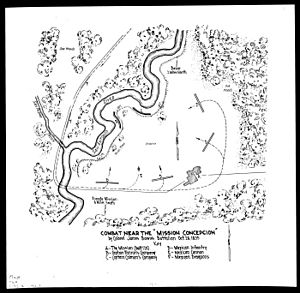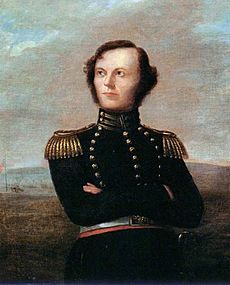Battle of Concepción facts for kids
Quick facts for kids Battle of Concepción |
|||||||
|---|---|---|---|---|---|---|---|
| Part of the Texas Revolution | |||||||
 The battle occurred on the grounds of Mission Concepción. |
|||||||
|
|||||||
| Belligerents | |||||||
| Texian Rebels | |||||||
| Commanders and leaders | |||||||
| James Bowie James Fannin |
Domingo Ugartechea | ||||||
| Strength | |||||||
| 90 militia | 275 infantry & cavalry 2 cannons |
||||||
| Casualties and losses | |||||||
| 1 killed 1 wounded |
14-76 killed 39 wounded |
||||||
The Battle of Concepción was a short but important fight during the Texas Revolution. It happened on October 28, 1835. Mexican troops, led by Colonel Domingo Ugartechea, fought against Texian rebels. The Texians were led by James Bowie and James Fannin.
This battle lasted only 30 minutes. It took place near Mission Concepción, about 2 miles (3 km) south of what is now Downtown San Antonio, Texas. Historians call it "the first major engagement of the Texas Revolution".
On October 13, the new Texian Army began marching towards Bexar. General Martín Perfecto de Cos commanded the Mexican soldiers there. On October 27, Stephen F. Austin, the Texian leader, sent Bowie and Fannin with 90 soldiers. Their job was to find a good place for the army to rest near Bexar. They chose a spot near Mission Concepción and camped for the night. They sent a message back to Austin.
When General Cos learned the Texian Army was split, he sent Ugartechea with 275 soldiers to attack. The Texians found good cover in a horseshoe-shaped gully. Their strong defensive spot, longer-range rifles, and better ammunition helped them. They fought off several Mexican attacks. The Mexican soldiers retreated just 30 minutes before the rest of the Texian Army arrived. Historians believe 14 to 76 Mexican soldiers were killed. Only one Texian soldier died.
Contents
Why the Battle Happened
The Texian Army wanted to end Mexican control over Texas. So, on October 13, 1835, they started marching towards San Antonio de Bexar. Days before, General Martín Perfecto de Cos had arrived in Bexar. He was the Mexican president's brother-in-law and took charge of all Mexican forces in Texas.
By October 20, the Texians had reached Salado Creek. They began a siege of Béxar, trying to surround the city. Mexican troops tried to stop people from entering or leaving Bexar. But many people still managed to leave their homes and join the Texians. One of them was James Bowie. He was famous for his fighting skills and adventures.
On October 22, Austin made Bowie a colonel. He gave him joint command of the 1st Battalion with Captain James W. Fannin. That evening, the 1st Battalion started a scouting mission. They looked at old missions around San Antonio to find good campsites. Local guides, including Juan Seguín and his Texian group, led them along the river. After checking three missions, Bowie and Fannin picked Mission San Francisco de la Espada as the best camp. The rest of the Texian Army joined them there later.
Before the Fight Began

Bowie and Fannin had 90 soldiers with them. These soldiers were split into four companies. They followed the San Antonio River north, past Missions San Juan and San José. On their way, they met a small group of Mexican scouts. After a short fight, the scouts went back to Bexar.
The Texian scouting party stopped at Mission Concepción. This was about 2 miles (3 km) from San Antonio de Bexar. It was also about 6 miles (10 km) from the main Texian camp at Espada. About 500 yards (457 m) west of the mission, the San Antonio River made a small horseshoe shape. The two sides of this curve were about 100 yards (91 m) apart. Historian Alwyn Barr noted that "trees shaded both sides of the broad riverbottom". This area was about six feet (1.8 m) lower than the nearby prairie.
Instead of going straight back to Austin, Bowie and Fannin sent a messenger. They told Austin to bring the army to Concepción. The next day, Austin was angry. He issued a statement threatening officers who did not follow orders with a court-martial (a military trial).
The Texian scouting party set up two camps. Fannin oversaw 49 men at the south part of the horseshoe bend. Bowie and the rest camped at the northern part. This way, any Mexican force coming from the north would be caught between them. Guards were placed around the area and in the mission tower for better views. As evening came, the Texians were surprised. A Mexican cannonball, fired from Bexar, landed just beyond their camp. Many Texian soldiers thought a priest from the mission had told the Mexican Army where they were.
The Battle of Concepción
General Cos wanted to defeat the Texian force at Concepción before the rest of the Texian Army arrived. So, he ordered Colonel Domingo Ugartechea to attack early on October 28. At 6:00 a.m., Ugartechea left Bexar with 275 Mexican soldiers and 2 cannons. Thick fog slowed them down. The Mexican soldiers did not reach Concepción until 7:30 or 8:00 a.m.
A Mexican cavalry scout fired at Texian guard Henry Karnes. Karnes fired back and then ran to his company. He was frustrated because, as he said, "Boys, the scoundrels have shot off my powder horn." The Texians quickly took cover in the gully. They fired from the edge, then dropped 6 feet (1.8 m) down to the river level to reload. As the last Texian guards rushed to join the main group, Pen Jarvis was hit by a Mexican bullet. He fell down the river bank. Luckily, the bullet hit a knife in his belt. He only got bruises.
The Texian position was surrounded by trees. This meant the Mexican cavalry could not move easily. The 200 cavalry members stayed on the west bank of the river, behind the Texians. Their goal was to stop any escape. Lieutenant Colonel José Maria Mendosa led the Mexican infantry and artillery across the river. They took a position below the Texians. In response, Texians cut away bushes near their camp for better visibility. They also dug steps into the river bank to climb up and fire more easily.
Both sides fought for two hours. The fog then began to lift. At that point, 50 to 60 Mexican infantrymen crossed the prairie to surround the Texians. Seeing them approach, Bowie shouted to his Texian forces, "Keep under cover, boys, and reserve your fire; we haven't a man to spare!"
The Mexican infantry stopped about 300 yards (274 m) from the Texian position. They formed a line with the cannon in the middle. They began firing as they moved towards the Texian positions, but it had little effect. Most of the Mexican shots went over the Texians' heads. Texian Noah Smithwick said, "grapeshot and canister thrashed through the pecan trees overhead, raining a shower of ripe nuts down on us." He saw men picking them up and eating them calmly. Bowie reported that the enemy's firing was "one continued blaze of fire." But the Texians fired more slowly, "with good aim and deadly effect."
The Mexican infantry used Brown Bess muskets. These guns had a maximum range of only 70 yards (64 m). The Texian long rifles, however, could hit targets effectively up to 200 yards (183 m) away. The Texians were low on ammunition. Mexican ammunition was plentiful, but it was poor quality. In some cases, Mexican musket balls bounced off Texian soldiers, causing only bruises.
Mexican officers ordered a charge on the south bend, where Fannin's men were. Bowie sent Coleman's company to help. Most Texian reinforcements moved to their new spot from below the river bank. But some ran across the open prairie. One of them, Richard Andrews, was hit in the side by grapeshot (small metal balls fired from a cannon). He died several hours later.
As the reinforcements reached the south part of the horseshoe, the Mexican infantry fell back. They left their cannon within 100 yards (91 m) of the Texians. The Texians then aimed their fire at the cannoneers. After three different groups of gunners were killed or wounded, the cannons were left behind. The Mexican infantry tried three more attacks, but all were stopped. When the Mexican buglers called for a retreat, the infantry fell back out of Texian rifle range.
The Mexican cavalry was sent to get wounded men and the cannon. As the cavalry came closer, Bowie led a charge onto the prairie. The Texians quickly captured the cannon. They turned it on the fleeing Mexican soldiers. Grapeshot killed one of the mule drivers. This made his caisson (a wagon carrying ammunition) go out of control. It crashed "through the shattered Mexican ranks." The entire battle had lasted only 30 minutes.
What Happened After
Austin had planned to bring his two army groups together early on October 28. But the group at Mission Espada was delayed. They had tried to catch a company that had run away. Lieutenant Colonel William Barret Travis and his cavalry company rode ahead of the main army. When they reached Concepción, the Mexican Army was still visible in the distance. The small group of Texian cavalry chased them, but the Mexican soldiers reached Bexar safely.
Less than 30 minutes after the battle ended, the rest of the Texian Army arrived. Austin felt that the Mexican soldiers must be discouraged after their defeat. He wanted to go straight to Bexar. But Bowie and other officers refused. They believed Bexar was too strongly defended. The Texians searched the area for any Mexican equipment left behind. They found several boxes of cartridges. The Texians complained that the Mexican gunpowder was "little better than pounded charcoal." So, they emptied the cartridges but kept the bullets.
That evening, Austin allowed a local priest and men from Bexar to collect the bodies of the Mexican soldiers who had died. Historian Barr estimated that at least 14 Mexican soldiers were killed. Another 39 were wounded, and some of them died later. Other historians, like Timothy Todish, estimate that 60 Mexican soldiers were killed. Stephen Hardin claimed that 76 Mexican soldiers died. The only Texian to die in battle was Andrews. Jarvis was the only Texian listed as wounded.
This battle was the first major fight of the Texas Revolution. It was also the last attack that General Cos would order against the Texians. Barr said the Texian victory was due to "able leadership, a strong position, and greater firepower." The Mexican cavalry could not fight well in the wooded, river bottom area. Also, the Mexican infantry's weapons had a much shorter range than the Texians' rifles.
Barr believed the battle "should have taught... lessons on Mexican courage and the value of a good defensive position." However, Hardin thought that "the relative ease of the victory at Concepción instilled in the Texians a reliance on their long rifles and a contempt for their enemies." A soldier who later served under Fannin complained that Fannin's "former experience in fighting Mexicans [at Concepción] had led him to neglect to take such precautionary measures as were requisite." This might have contributed to Fannin's defeat at the Battle of Coleto in March 1836.
Images for kids
See also
 In Spanish: Batalla de Concepción (1835) para niños
In Spanish: Batalla de Concepción (1835) para niños







